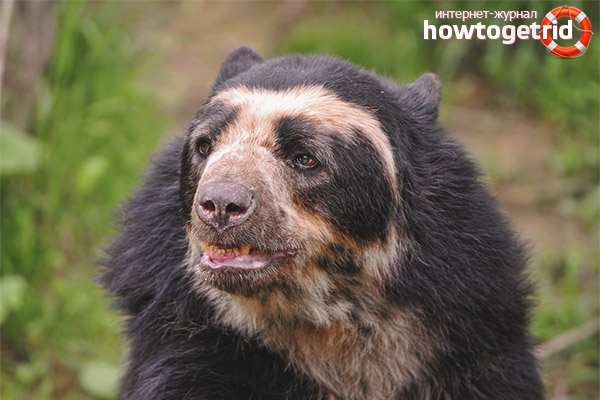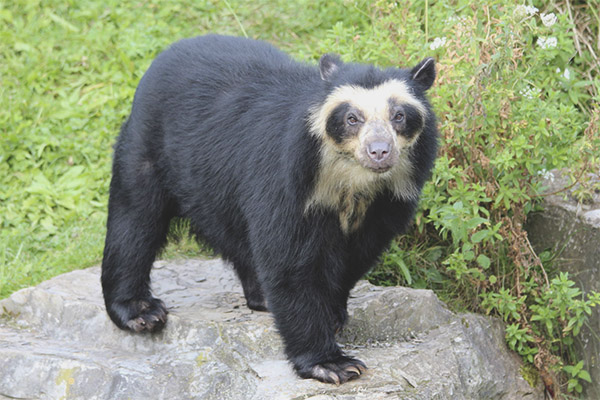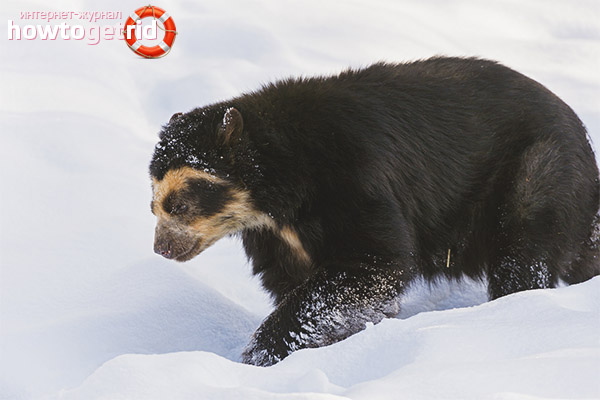The content of the article
Many scientists and zoologists argue that the bear can be called one of the most intelligent creatures on planet Earth. These animals are distinguished not only by their impressive size and intimidating appearance, but also attract by their unique grace, charisma, inspiring a sense of delight and awe in a person. There are many varieties of such predatory individuals, each of which has distinctive features and traits, for example, structure, behavior, coloring. Let's get acquainted closer with such a little-known representative of bears, like a spectacled bear.
Habitat and appearance
Meet the spectacled bear in the wild is becoming increasingly difficult. This species has long belonged to the list of animals listed in the Red Book. For zoos to see the spectacled bear among its wards is an impossible dream.Local residents are carrying out a mass extermination of such predators, as they fear attacks on livestock or the destruction of crops on their part. In addition, the gallbladder of a bear is used for medical purposes to treat certain diseases.
Every year, the volume of deforestation increases, the zone of construction objects expands, the places of accumulation of bears are under threat, which affects the decline in the population. Spectacled bears are found mainly in difficult mountainous areas. In this regard, about him is not so much known as about other species.
The growth of the predator is about 1.5-2 m, its weight reaches 140 kg. Females are smaller than males. The animal fur is black with a slight brown tinge.
The muzzle looks slightly shortened compared to the relatives. The origin of the name spectacle bear has to do with light spots located on the muzzle in the eye area and smoothly connecting on the neck.
According to scientists, the animal may be the last descendant of a huge bear, which existed thousands of years ago. Then the weight of these predators approached 500-600 kg. There were even cases when individuals reached weights of the order of 1 tone.The body looks strong and muscular. The neck is short, the limbs withstand severe stress. A pair of hind legs is shorter than the front legs, so the spectacled bears can climb a tree excellently.
The skeleton structure also differs significantly from other species. The rest of the bear family have 14 rib pairs in the body, and the spectacled bears have one pair of ribs less.
Character traits and behavior
The spectacled bear is one of the most placid and harmless bears of its kind. It is rare to hear stories of attacks on people. Even fighting with other animals is not fatal. They can only hurt the enemy if he is a threat. If a bear encounters a person, the animal tries to hide in the trees. Prefers a closed lifestyle. The question of the division of territory between males does not arise.If the area inhabited by individuals is rich in food, then the animals live together next to each other without conflict. Unlike brown bears, spectacled bears do not need hibernation or lairs. They are nocturnal, and in daylight they fall asleep in their own nests, settling in among the thickets.
Nutrition

Eyeglass bears feed mainly on vegetation. Meat food is included in the diet only in small quantities. Hunting is opened on small rodents, deer, birds or rabbits.
When hunger comes, make raids and attack livestock, eat carrion. Due to the unique structure of the muzzle and the long tongue, the animal is able to produce insects, termites from narrow crevices and nests. Honey is a favorite delicacy for which they hunt and destroy beehives.
The assimilation of plant food is poorly tolerated by animals, but the spectacle bears use both grass shoots, fruits, and rhizomes. Powerful jaws can compete even with the jaw of a huge panda, easily splitting food that is inaccessible to other animals. In the bearish diet includes the bark of trees and palm branches.Such solid food in the teeth.
Bears do not bypass the cacti, climbing up the trunk, where the most delicious fruits grow. From time to time the animals wander into the territory of agricultural fields owned by local authorities and farmers. Sugar cane - a delicacy that interests them.
Breeding patterns and longevity
The process of mating of these predators can occur throughout the year, however, spring and the beginning of summer before the onset of the rainy season is considered the peak of activity. As soon as the female shows that she wants to mate, the male individuals start an exemplary fight between them, waiting for her to give preference to one of them.
After a pair is formed, ready for breeding, the animals live together for some time. Scientists have not been able to fully explore the habits of bears at this stage of life. However, it turned out that the female's body easily adapts to the conditions of an unplanned pregnancy. The fertilized egg continues to divide and remain inside the uterus for a long time.The possibility of delaying the implantation allows the body to prepare and give birth to the cubs in a favorable period when the female is ready to feed the offspring.
Pregnancy of spectacle animals proceeds over eight months. As a rule, from 1 to 3 cubs are born. Blind crumbs can weigh about 300 g. The bear cubs skin has a distinctive black color with a yellow spot inherent only in this species.
Scientists have shown that there is a great similarity between the brown and the spectacled bears, but genetic exchange is impossible. When mating different species, the reproductive properties of the organism are disturbed. Even if viable offspring appears, the continuation of the species will not follow.
Brown and spectacled bears live about the same - about 25 years.It was once noted that the captive male who lived in captivity lived up to 36 years.
All representatives of the animal and plant world are wonderful and interesting creatures, unique in their own way and representing a high value for our future generation, which still has much to discover and explore.
Video: spectacled bear (Tremarctos ornatus)












To send